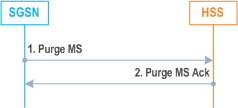Content for TS 23.060 Word version: 18.0.0
1…
5…
5.3.8…
5.4…
5.4.2…
5.4.9…
5.6…
5.6.2
5.6.3…
5.6.3.7…
5.7…
6…
6.3…
6.5…
6.6…
6.8…
6.9…
6.9.1.3
6.9.2…
6.9.2.2…
6.9.2.2.2
6.9.2.2.3…
6.9.2.2.5…
6.9.3…
6.10…
6.12…
6.13…
6.13.1.2…
6.13.2…
6.13.2.2
6.14…
8…
8.2
9…
9.2.2…
9.2.2.2
9.2.2.3…
9.2.3…
9.2.3.2…
9.2.3.3…
9.2.4…
9.2.4.2…
9.2.5…
12…
12.5…
12.6…
12.7…
12.8…
13…
14…
15…
15.3…
16…
16.2…
A…
B…
6.6 Detach Function
6.6.1 MS-Initiated Detach Procedure
6.6.2 Network-Initiated Detach Procedure
6.6.3 SGSN interaction during Detach Procedure when using S4
6.7 Purge Function
...
...
6.6 Detach Function p. 99
The GPRS Detach procedure allows:
- an MS to inform the network that it does not want to access the SGSN-based services any longer; and
- the network to inform an MS that it does not have access to the SGSN-based services any more.
- IMSI detach;
- GPRS detach; and
- combined GPRS / IMSI detach (MS-initiated only).
- Explicit detach: The network or the MS explicitly requests detach.
- Implicit detach: The network detaches the MS, without notifying the MS, after the implicit detach timer expired, or after an irrecoverable radio error causes disconnection of the logical link.
- A GPRS-attached MS sends a Detach Request message to the SGSN, indicating an IMSI detach. This can be made in combination with GPRS detach.
- An MS that is not GPRS-attached makes the IMSI detach as already defined in A/Gb mode or Iu mode.
6.6.1 MS-Initiated Detach Procedure p. 100
The MS-Initiated Detach procedure when initiated by the MS is illustrated in Figure 23.
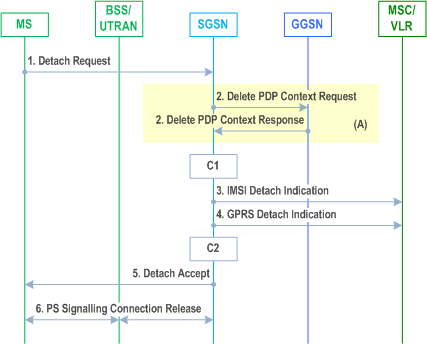
Step 1.
The CAMEL procedure calls shall be performed; see referenced procedures in TS 23.078:
The MS detaches by sending Detach Request (Detach Type, P-TMSI, P-TMSI Signature, Switch Off) to the SGSN. Detach Type indicates which type of detach is to be performed, i.e., GPRS Detach only, IMSI Detach only or combined GPRS and IMSI Detach. Switch Off indicates whether detach is due to a switch off situation or not. The Detach Request message includes P-TMSI and P-TMSI Signature. P-TMSI Signature is used to check the validity of the Detach Request message. If P-TMSI Signature is not valid or is not included, the authentication procedure should be performed.
If the SGSN receives a Detach Request via a CSG cell with Switch Off parameter indicating that detach is not due to a switch off situation, and the CSG subscription for this CSG ID and associated PLMN is absent or expired, the SGSN shall trigger a SGSN-initiated Detach procedure as specified in clause 6.6.2.1.
Step 2.
If GPRS detach, the active PDP contexts in the GGSNs regarding this particular MS are deactivated by the SGSN sending Delete PDP Context Request (TEID, CGI/SAI) to the GGSNs. The GGSNs acknowledge with Delete PDP Context Response (TEID). The GGSN may interact with PCRF (refer to TS 23.203), e.g. to deliver User Location Information and/or UE Time Zone if it was requested by the PCRF. For any active T6b connection(s) the SGSN indicates to the SCEF that the connection for the MS is no longer available according to TS 23.682.
Step 3.
If IMSI detach, the SGSN sends an IMSI Detach Indication (IMSI) message to the VLR.
Step 4.
If the MS wants to remain IMSI-attached and is doing a GPRS detach, the SGSN sends a GPRS Detach Indication (IMSI) message to the VLR. The VLR removes the association with the SGSN and handles paging and location update without going via the SGSN.
Step 5.
If Switch Off indicates that detach is not due to a switch off situation, the SGSN sends a Detach Accept to the MS.
Step 6.
If the MS was GPRS detached, then the 3G SGSN releases the PS signalling connection.
C1)
CAMEL_GPRS_PDP_Context_Disconnection.
This procedure is called several times: once per PDP context. The procedure returns as result "Continue".
C2)
CAMEL_GPRS_Detach and CAMEL_PS_Notification.
They are called in the following order:
- The procedure CAMEL_GPRS_Detach is called. The procedure returns as result "Continue".
- Then the procedure CAMEL_PS_Notification is called. The procedure returns as result "Continue".
6.6.2 Network-Initiated Detach Procedure p. 101
6.6.2.1 SGSN-Initiated Detach Procedure p. 101
The SGSN-Initiated Detach procedure when initiated by the SGSN is illustrated in Figure 24.
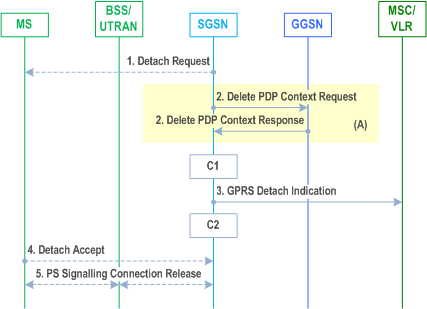
Step 1.
The CAMEL procedure calls shall be performed, see referenced procedure in TS 23.078:
The SGSN informs the MS that it has been detached, by sending Detach Request (Detach Type) to the MS. Detach Type indicates if the MS is requested to make a new attach and PDP context activation for the previously activated PDP contexts. If so, the attach procedure shall be initiated when the detach procedure is completed.
If this Detach procedure is due to the MS's Detach Request via a CSG cell which the MS is not allowed to access, i.e. the CSG subscription for this CSG ID and associated PLMN is absent or expired, the SGSN shall send a Detach Request to MS with an appropriate cause indicating the MS is not allowed to access this CSG.
Step 2.
The active PDP contexts in the GGSNs regarding this particular MS are deactivated by the SGSN sending Delete PDP Context Request (TEID, CGI/SAI) messages to the GGSNs. The GGSNs acknowledge with Delete PDP Context Response (TEID) messages. The GGSN may interact with PCRF (refer to TS 23.203), e.g. to deliver User Location Information and/or UE Time Zone if it was requested by the PRCF. For any active T6b connection(s) the SGSN indicates to the SCEF that the connection for the MS is no longer available according to TS 23.682.
Step 3.
If the MS was both IMSI- and GPRS-attached, the SGSN sends a GPRS Detach Indication (IMSI) message to the VLR. The VLR removes the association with the SGSN and handles paging and location update without going via the SGSN.
Step 4.
The MS sends a Detach Accept message to the SGSN any time after step 1. If the MS receives Detach Request from the SGSN via a CSG cell with the cause indicating the MS is not allowed to access this CSG, the MS shall remove this CSG ID and associated PLMN from its Allowed CSG list, if present.
Step 5.
After receiving the Detach Accept message, if Detach Type did not request the MS to make a new attach, then the 3G SGSN releases the PS signalling connection.
C1)
This procedure is called several times: once per PDP context. The procedure returns as result "Continue".
CAMEL_GPRS_PDP_Context_Disconnection.
C2)
CAMEL_GPRS_Detach and CAMEL_PS_Notification.
They are called in the following order:
- The procedure CAMEL_GPRS_Detach is called. The procedure returns as result "Continue".
- Then the procedure CAMEL_PS_Notification is called. The procedure returns as result "Continue".
6.6.2.2 HLR-Initiated Detach Procedure p. 102
The HLR-Initiated Detach procedure is initiated by the HLR. The HLR uses this procedure for operator-determined purposes to request the removal of a subscriber's MM and PDP contexts at the SGSN. The HLR-Initiated Detach Procedure is illustrated in Figure 25.
For MS with emergency PDP Context, the SGSN shall not send detach message to MS. Instead the SGSN shall deactivate all the non emergency PDP Contexts.
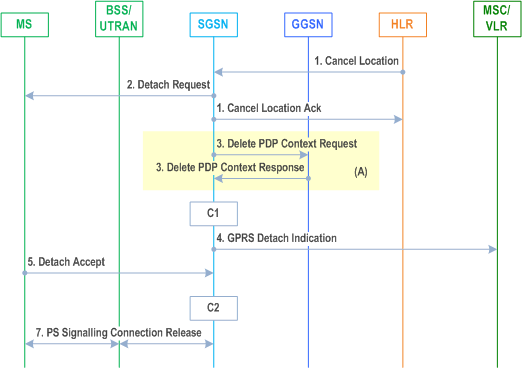
Step 1.
The CAMEL procedure calls shall be performed, see referenced procedures in TS 23.078:
If the HLR wants to request the immediate deletion of a subscriber's MM and PDP contexts from the SGSN, the HLR shall send a Cancel Location (IMSI, Cancellation Type) message to the SGSN with Cancellation Type set to Subscription Withdrawn. When receiving the Cancel Location Message the SGSN acknowledges with a Cancel Location Ack (IMSI) message to the HLR.
Step 2.
The SGSN shall inform the MS that it has been detached by sending Detach Request (Detach Type) to the MS. If the Cancel Location message includes a flag to indicate that re-attach is required, the SGSN shall perform detach and set the Detach Type to indicate that re-attach is required.
Step 3.
The active PDP contexts in the GGSNs regarding this particular MS are deactivated by the SGSN sending Delete PDP Context Request (TEID, CGI/SAI) messages to the GGSNs. The GGSNs acknowledge with Delete PDP Context Response (TEID) messages. The GGSN may interact with PCRF (refer to TS 23.203), e.g. to deliver User Location Information and/or UE Time Zone if it was requested by the PRCF. For any active T6b connection(s) the SGSN indicates to the SCEF that the connection for the MS is no longer available according to TS 23.682.
Step 4.
If the MS was both IMSI- and GPRS-attached, the SGSN sends a GPRS Detach Indication (IMSI) message to the VLR. The VLR removes the association with the SGSN and handles paging and location update without going via the SGSN.
Step 5.
The MS sends a Detach Accept message to the SGSN any time after step 2.
Step 6.
Void.
Step 7.
After receiving the Detach Accept message, if Detach Type did not request the MS to make a new attach, then the 3G SGSN releases the PS signalling connection.
C1)
This procedure is called several times: once per PDP context. The procedure returns as result "Continue".
CAMEL_GPRS_PDP_Context_Disconnection.
C2)
CAMEL_GPRS_Detach and CAMEL_PS_Notification.
They are called in the following order:
- The procedure CAMEL_GPRS_Detach is called. The procedure returns as result "Continue".
- Then the procedure CAMEL_PS_Notification is called. The procedure returns as result "Continue".
6.6.3 SGSN interaction during Detach Procedure when using S4 |R8| p. 103
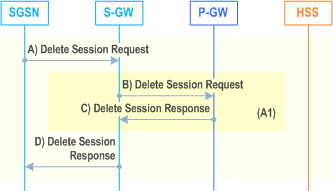
A)
Further messages due to ISR and messages between S-GW and P-GW are described in clause 5.3.8 "Detach procedure" of TS 23.401.
For each PDN connection, the EPS Bearer(s) in the Serving GW regarding this particular MS are deactivated by the SGSN by sending Delete Session Request to the Serving GW. This message indicates that all bearers belonging to that PDN connection shall be released. User Location Information is also reported in this message.
B)
The Serving GW sends Delete Session Request to the PDN-GW, including User Location Information. The PDN-GW may interact with PCRF (refer to TS 23.203), e.g. to deliver User Location Information and/or UE Time Zone if it was requested by the PRCF.
C)
The PDN-GW acknowledges the bearer deactivation to the S-GW by sending a Delete Session Response.
D)
The SGW acknowledges with Delete Session Response.
6.7 Purge Function p. 104
The Purge function allows an SGSN to inform the HLR that it has deleted the MM and PDP contexts of a detached MS. The SGSN may, as an implementation option, delete the MM and PDP contexts of an MS immediately after the implicit or explicit detach of the MS. Alternatively, the SGSN may keep for some time the MM and PDP contexts and the authentication triplets of the detached MS, so that the contexts can be reused at a later GPRS attach without accessing the HLR.
When the SGSN deletes the MM and PDP contexts, it shall initiate the Purge procedure as illustrated in Figure 26.
